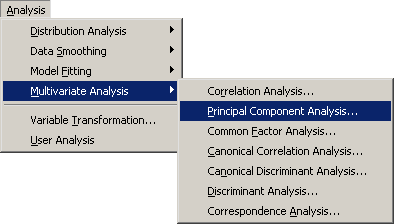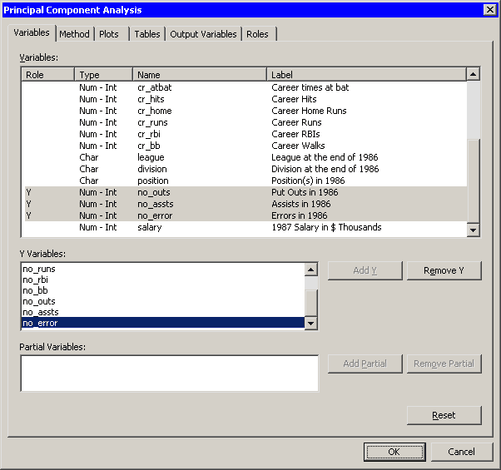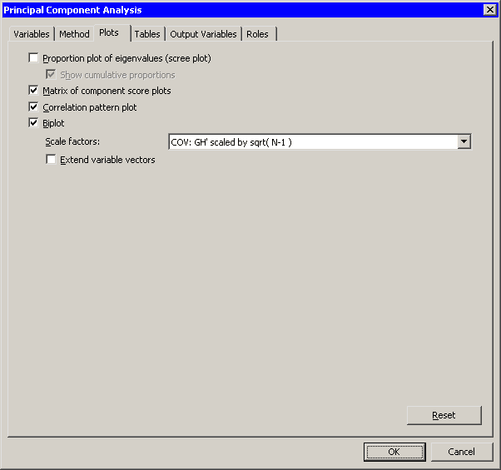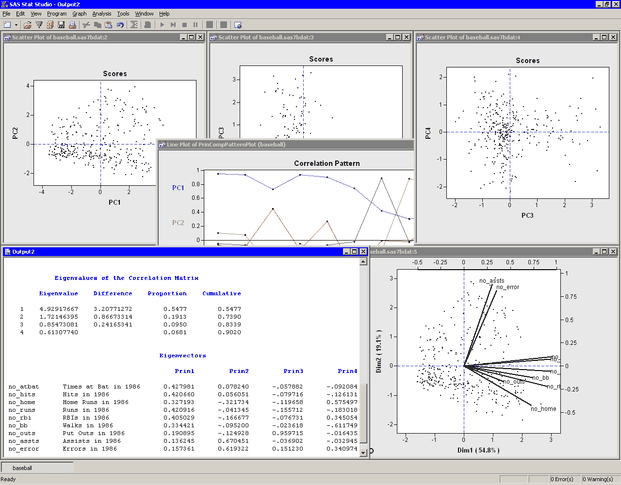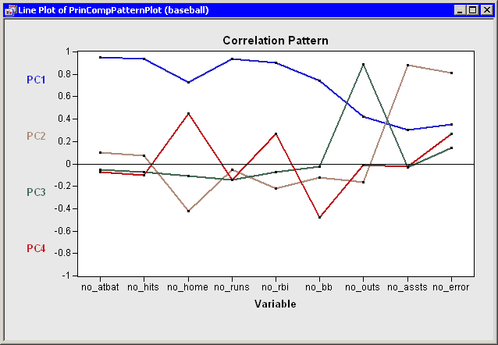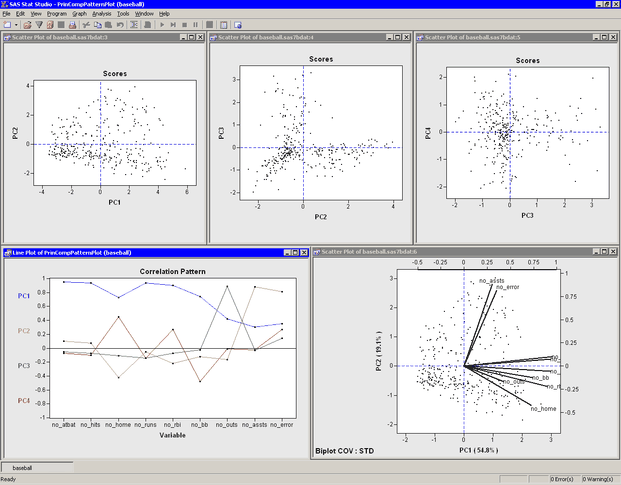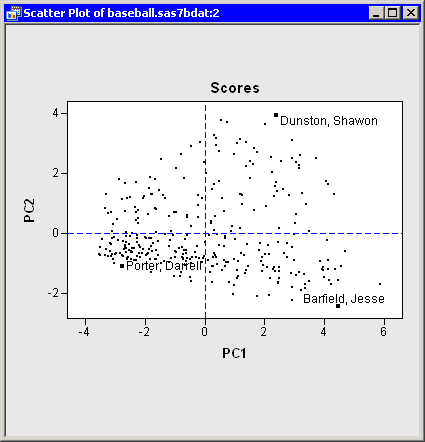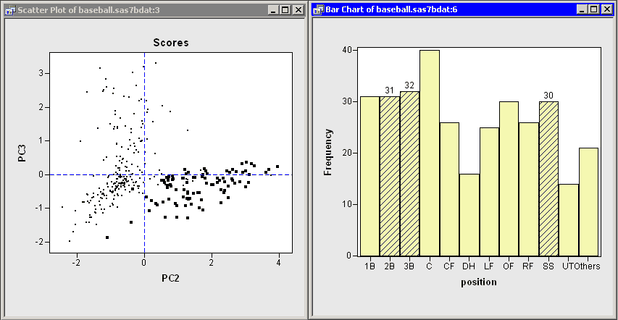In this example, you compute principal components of several variables in the Baseball data set. The Baseball data set contains performance measures for major league baseball players in 1986. A full description of the Baseball data is included in Appendix A: Sample Data Sets.
Suppose you are interested in exploring the sources of variation in players’ performances during the 1986 season. There are
six measures of players’ batting performance: no_atbat, no_hits, no_home, no_runs, no_rbi, and no_bb. There are three measures of players’ fielding performance: no_outs, no_assts, and no_error. These data form a nine-dimensional space. The goal of this example is to use principal component analysis to capture most
of the variance of these data in a low-dimensional subspace—preferably in two or three dimensions. The subspace will be formed
by the span of the first few principal components. (Recall that the span
of a set of vectors is the vector space consisting of all linear combinations of the vectors.)
To run a principal component analysis:
-
Select → from the main menu, as shown in Figure 26.1.
The Principal Component Analysis dialog box appears. (See Figure 26.2.) You can select variables for the analysis by using the Variables tab.
-
Select
no_atbat. While holding down the CTRL key, selectno_hits,no_home,no_runs,no_rbi, andno_bb. Click .Note: Alternately, you can select the variables by using contiguous selection: click the first item, hold down the SHIFT key, and click the last item. All items between the first and last item are selected and can be added by clicking .
The three measures of fielding performance are located near the end of the list of variables.
-
Scroll to the end of the variable list. Select
no_outs. While holding down the CTRL key, selectno_asstsandno_error. Click . -
Click the Method tab.
The Method tab becomes active. (See Figure 26.3.) You can use the Method tab to set options in the analysis.
By default, the analysis is carried out on the correlation matrix. The alternative is to use the covariance matrix. The covariance matrix is recommended only when all the variables are measured in comparable units. For this example, the correlation matrix is appropriate.
By default, the analysis computes all
 principal components for the
principal components for the  variables selected in the Variables tab. It is often sufficient to compute a smaller number of principal components.
variables selected in the Variables tab. It is often sufficient to compute a smaller number of principal components.
-
Set to
4. -
Click the Plots tab.
The Plots tab becomes active. (See Figure 26.4.)
-
Clear
-
Select .
-
Click .
The analysis calls the PRINCOMP procedure, which uses the options specified in the dialog box. The procedure displays tables in the output document, as shown in Figure 26.5. The “Simple Statistics” table displays the mean and standard deviation for each variable. (The “Simple Statistics” table is not visible in Figure 26.5. You can scroll through the output window to view it.) The “Correlation Matrix” table (also not shown) displays the correlation between each pair of variables.
The “Eigenvalues of the Correlation Matrix” table contains all the eigenvalues of the correlation matrix, differences between successive eigenvalues, the proportion of variance explained by each eigenvalue, and the cumulative proportion of the variance explained. The eigenvalues correspond to the principal components and represent a partitioning of the total variation in the sample. Because correlations are used, the sum of all the eigenvalues is equal to the number of variables. The first row of the table corresponds to the first principal component, the second row to the second principal component, and so on. In this example, the first three principal components account for over 83% of the variation; the first four account for 90%.
The “Eigenvectors” table contains the first four eigenvectors of the correlation matrix. The eigenvectors are principal component vectors. The first column of the table corresponds to the first principal component, the second column to the second principal component, and so on. Each principal component is a linear combination of the Y variables. For example, the first principal component corresponds to the linear combination
![\[ \mbox{PC}_1 = 0.42798 \: \mbox{\Variable{no\_ atbat}} + 0.42066 \: \mbox{\Variable{no\_ hits}} + \ldots + 0.15736 \: \mbox{\Variable{no\_ error}} \]](images/imlsug_ugmultpca0002.png)
The first principal component (
PC1) appears to be a weighted measure of the players’ overall performance, as seen by the relative magnitudes of the coefficients. More weight is given to batting performance (the batting coefficients are in the range 0.33–0.43) than to fielding performance (the fielding coefficients are in the range 0.14–0.19). The second principal component (PC2) is primarily related to theno_asstsandno_errorvariables. Players with large values ofPC2have many assists, but also relatively many errors. The third component (PC3) is primarily related to theno_outsvariable. The fourth component is a contrast betweenno_homeandno_bb(that is, between home runs and walks). This component separates players with many home runs and few walks from the players who often walk and rarely hit a home run.You can use the correlation pattern plot to examine correlations between the principal components and the original variables. (See Figure 26.6.)
For example, the first principal component (
PC1) is positively correlated with all of the original variables. It is correlated more with batting performance than with the fielding variables.The relationship between the original variables and observations is shown in the biplot, at the lower right of Figure 26.7. The line segments represent the projection of a vector in the direction of each original variable onto a two-dimensional subspace. The points in the biplot are the projection of the observations onto the same two-dimensional subspace. The section Biplots discusses biplots in further detail.
The plots tiled across the top of Figure 26.7 are called score plots. These are plots of the observations in the coordinate system defined by the principal components. For these data, each observation represents a player.
To set the value of the
namevariable to be the label you see when you click an observation: -
Click the score plot of
PC2versusPC1to activate it. -
Press the F9 key to display the data table that is associated with this plot.
-
Right-click the variable heading for
nameto display the menu. Select . -
Click in the upper left cell of the data table to deselect the variable.
-
Close the data table.
-
Click some observations in the score plot of
PC2versusPC1, as shown in Figure 26.8.
The first principal component measures a player’s hitting performance during the 1986 season. Consequently, players to the right (such as Jesse Barfield) had strong hitting statistics, whereas players to the left (such as Darrell Porter) had weaker statistics. The second principal component primarily measures the number of assists (and errors) for each player. Consequently, players near the top of the plot (such as Shawon Dunston) have many assists, whereas players near the bottom (such as Jesse Barfield) have few.
The score plot of the second and third principal components is interesting because it compares two different measures of fielding
performance. Also, there are few players in the first quadrant of the plot. Recall that the third principal component primarily
measures the no_outs variable. This variable records putouts. Common situations leading to a putout include tagging or forcing out a base runner, catching a fly ball, or (for catchers)
catching a third strike. The opportunities for a player to get a putout or an assist are highly dependent on the player’s
position.
Figure 26.9 shows the score plot for the positions of second base, third base, and shortstop. Note that these observations primarily lie in the fourth quadrant. These players have many assists because they often field ground balls and throw to first base, but they have relatively few opportunities to put out runners themselves. In contrast, Figure 26.10 shows the score plot for outfielders and designated hitters. These observations lie in the third quadrant. These players have few assists and relatively few putouts. (The outfielders are credited with a putout when they catch a fly ball, but there are many fewer fly balls than ground balls in a typical game.) Catchers and first basemen (not shown) have scores primarily in the second quadrant of the plot, corresponding to many putouts but few assists.
In summary, the analysis shows that most of the variation in these data occurs in the first principal component: an overall measure of batting performance. The next two principal components incorporate variation due to fielding performance. Figure 26.9 and Figure 26.10 show that the source of this fielding variation is differences in player positions. Together, these three components account for 83% of the variation in the nine-dimensional space of the original variables.
Principal components can also be used as explanatory variables in regression. For example, you could examine how well overall
batting performance in 1986 predicts a player’s salary by using PC1 as an explanatory variable in a regression model.
